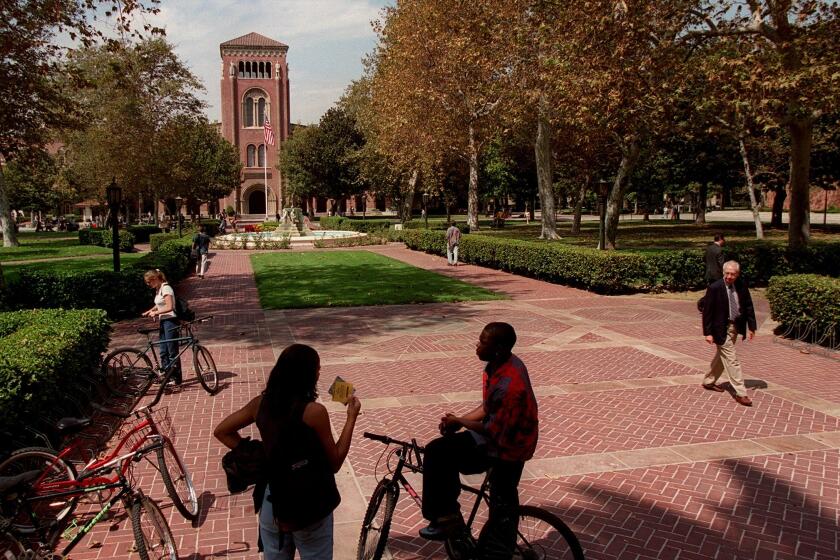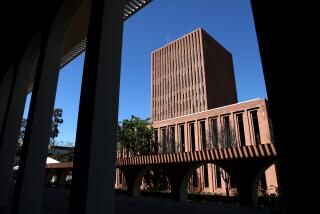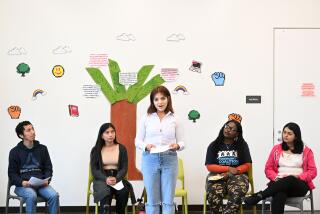Op-Ed: Nearly all in-person USC classes will also be online. But remote learning doesn’t cut it

- Share via
After I transitioned to teaching online during the spring semester at USC, I admitted to my students that this was new territory for me. This was also the first time many of them had participated in distance learning, so we bonded over sharing a new experience in a drastically changed world. We’d already established a rapport in the physical classroom and were optimistic that we could make the best of the situation. Moving online did change the dynamic of the class — and not for the better.
When USC announced Tuesday that fall semester classes will be held on campus, the realist in me became nervous about the potential health consequences in the time of the coronavirus. But the teacher in me is relieved that students will be able to gain the enormous benefits derived from learning in a physical classroom. Yet many classes are expected to be a mix of online and in-person learning, so my virtual-teaching dilemma is not going to go away.
This hybrid approach is supposed to offer students and faculty “more flexibility.” Adapting teaching skills to improve student participation online or to make sure no one gets lost is no guarantee that the benefits of a quality education will transition to an online platform — even if students are sitting in a physical classroom part time.
USC will bring students back to campus this fall, with online and in-person classes and more spacing in dorms as safety measures amid the coronavirus crisis, President Carol L. Folt announced Tuesday.
It’s impossible to ignore the well-documented reality of high attrition rates for online or distance education. Researchers have long explored innovative ways to promote student success online, yet the dropout rates remain 10% to 20% higher than at four-year universities where about 60% of students graduate within six years. Even if you can get beyond the mundane challenges of online learning — the muting and unmuting, the electronic hand-raising, asking questions by typing them into a box — it’s disconcerting having your face fill everyone’s screen when you comment, as if you are making some brilliant contribution.
Technology is the great inhibitor, making class interactions feel more performative instead of being a free-flowing exchange of ideas among equals.
Socioeconomic disadvantages always present the biggest challenges to college success, and it’s no different when a course moves online. I get to know the students in my small classes, and when our courses shifted online, most students from more modest backgrounds kept their cameras off and transitioned to a name in a Zoom box.
Others were in dark closets or tight corners of apartments where family members would sometimes meander into view — usually to the student’s obvious embarrassment. These few were in stark contrast to the students lounging in bedrooms, by pools or against the lush green backdrop of backyards. Those who hid essentially ceased making any valuable verbal contributions to the class. They saw what I saw, and they chose to retreat.
Online education also has disadvantages that affect all socioeconomic groups. One of the greatest benefits of attending college is entering a room where strangers from various backgrounds are encouraged to feel comfortable with intellectual risk-taking and having their beliefs challenged. But when you’re back in your childhood bedroom or sitting at the kitchen table interacting with a screen, the ideas might not flow so easily. Or perhaps college has caused you to see things differently from your family, and it might be harder to articulate your convictions knowing that a relative in the next room might be outraged by your new perspectives.
Even when Zooming from my home office with the door closed, I’m distracted by my family’s proximity (not to mention barking dogs and ringing phones). Online, I’m also a prisoner of my computer screen and sometimes unreliable Wi-Fi. I can’t move around the room the way I normally do, I can’t make my usual asides, and I can’t easily blend into the classroom milieu when a discussion among students takes off.
It’s simply harder to engage the class. So much subtle communication occurs in the physical classroom. I can see the student who looks like she has something to say and prod her to speak up, or I can see the student who’s clearly irked by someone else’s comment and ask if he wants to respond.
Class after class, week after week, I’ve watched students grow familiar just by being in each other’s presence. They might see the classmate with all the piercings and scarred wrists who has “Christian” tattooed on the back of her hand, they might notice the frat boy who wears rainbow socks on the last day of Pride Week, or they might soften up to the silent guy with the sour expression when they realize he’s had the same breast cancer awareness pin in a prominent spot on his backpack all semester.
The physical classroom provides a humanizing and unifying experience for everyone present that can help us not only to hone our skills of focus and observation but also to challenge our assumptions about people and become a little more open-minded, a little less isolated and a lot less egocentric. Awareness of each other’s strengths, vulnerabilities and individuality serves as a complement to the exchange of ideas and the intellectual development that a quality education provides.
Research on college completion cites the importance of both academic success and social success for students. Online courses might deliver quality academic content, but they squelch opportunities to cultivate the subtle wisdom derived from sharing the same physical space with a diverse group of learners working toward a common goal.
In person, I get to know all of my students, not just the most confident, motivated or outspoken ones. Those connections make me believe I can make an impact that might empower them as learners — and as citizens of the increasingly challenging world they’ll be navigating.
Teaching them online, even part time, gets in the way of that.
John R. Murray is an associate professor of teaching in the undergraduate writing program at USC.
More to Read
A cure for the common opinion
Get thought-provoking perspectives with our weekly newsletter.
You may occasionally receive promotional content from the Los Angeles Times.











